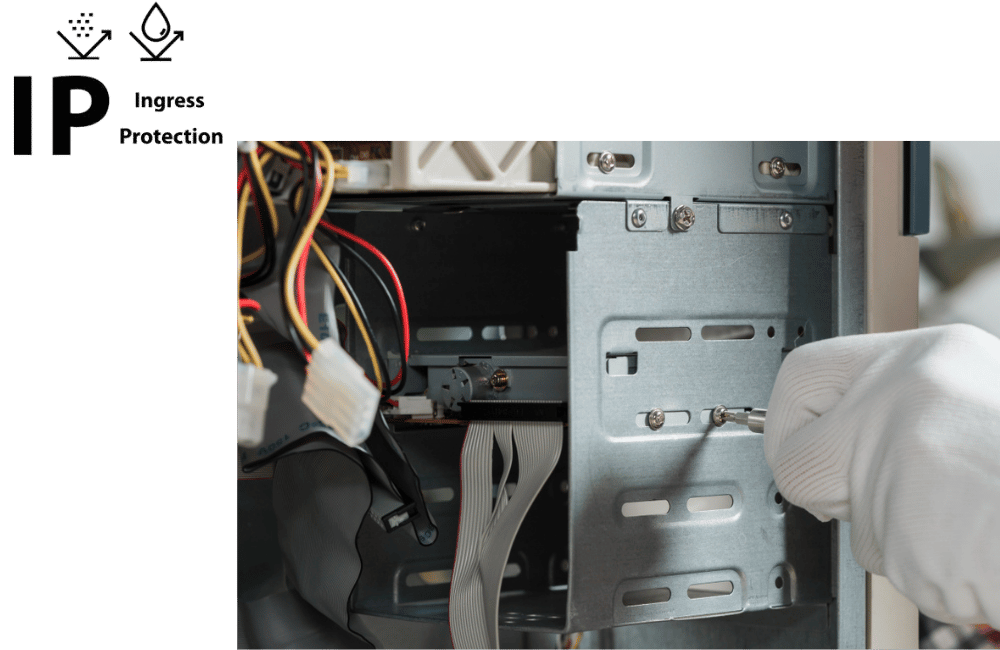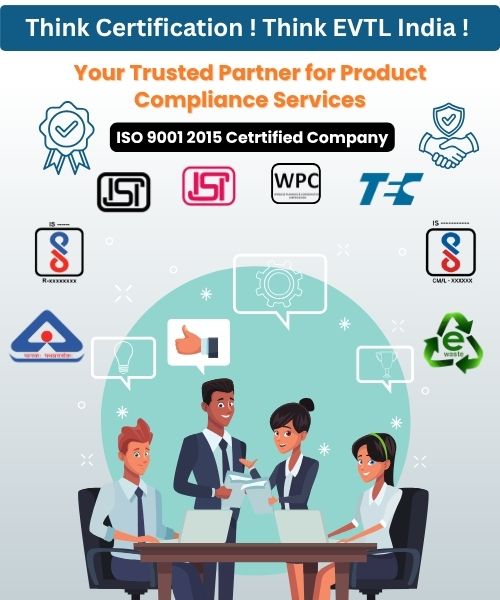Get A Quote
IP Rating Test - Ingress Protection Ratings as per IEC 60529
EVTL India is a trusted leader in regulatory compliance, specializing in comprehensive IP rating testing solutions. Our expert team, available 24/7, ensures your products meet global standards for protection against dust, water, and other environmental factors, helping you achieve full regulatory compliance for reliable and durable performance.

- Overview
- Purpose and Importance of IP Rating Tests
- What is Ingress Protection (IP)?
- How the IP Rating Test Works
- IP Testing Standards: IEC 60529
- Common IP Ratings and Their Interpretations
- IP Testing Required for IEC 60529 Rating
- Applications and Benefits of IP Ratings Across Industries
- IP Ratings in Consumer Electronics and Industrial Equipment
- Conclusion
- Frequently Asked Question (FAQ)
IP Ratings - Overview
The IP rating, which stands for Ingress Protection rating , is a globally recognized standard used to describe the level of protection an enclosure provides against dust, solid objects, water, and other environmental factors. IP ratings are crucial for ensuring that products—ranging from consumer electronics like smartphones to industrial equipment and outdoor lighting—are able to perform reliably in challenging environments.

By specifying a product's resistance to various elements, IP ratings help users understand how well a device will hold up in situations where exposure to dust, moisture, and other potential hazards is a concern.
What is Ingress Protection (IP)?
Ingress Protection (IP) ratings specifically indicate the effectiveness of a product’s enclosure in preventing the entry of solid particles (such as dust), liquids (such as water), and other external objects. This rating is particularly important in electronics and industrial applications, where even minor ingress can cause significant malfunctions or failures. The IP rating ensures that a device can function as intended, even in extreme environments. Testing is conducted according to IEC 60529 standards, which outline the methods and conditions under which these ratings are determined. By evaluating a product's resistance to dust and moisture, the IP rating provides assurance that the device will continue to operate reliably in its intended environment.
Purpose and Importance of IP Rating Tests
IP rating tests are designed to evaluate how effectively an enclosure protects internal components from environmental elements such as dust, water, and other intrusions. These tests are particularly important for products that will be used in harsh environments, such as outdoor or industrial settings, where exposure to elements like rain, dust, and dirt could otherwise cause damage. Although these tests are not always mandatory, they are often requested by manufacturers and purchasers to ensure that products meet the necessary standards for durability and reliability. For example, an IP rating can confirm that a mobile device is dust-resistant and waterproof or that a lighting fixture is suitable for outdoor use in rainy conditions.
Understanding the IP Rating System
An IP rating consists of two digits:
- First digit (Solid Protection): This measures the level of protection against solid particles, such as dust or debris, ranging from 0 (no protection) to 6 (complete dust-tightness).
- Second digit (Liquid Protection): This measures the level of protection against water and other liquids, ranging from 0 (no protection) to 9 (protection against high-pressure, high-temperature water jets).
For example, in an IP67 rating, the "6" signifies complete dust protection, while the "7" indicates that the product is resistant to temporary immersion in water. This means the device is fully sealed against dust and can handle being submerged in water up to a specified depth for a set duration.
How the IP Rating Test Works
IP rating tests are conducted according to standardized procedures to simulate real-world environmental challenges:
- Dust Tests: The product is placed in a dust chamber where fine particles are introduced. The device is tested to ensure it remains functional despite prolonged exposure to dust, verifying its ability to operate in environments where dust or airborne particles could otherwise disrupt its performance.
- Water Resistance Tests: The device is subjected to different levels of water exposure, including sprays, immersion, or high-pressure jets, to assess how well it resists water ingress. The tests are conducted under controlled conditions, with guidelines on water pressure, spray angles, and immersion depths as specified by the IEC 60529 standards.
These tests are designed to mimic real-life conditions, helping manufacturers confirm that their products will perform as expected when exposed to environmental hazards.
IP Testing Standards: IEC 60529
IEC 60529 is the primary standard that defines how products are tested for their ingress protection. This standard was established to help manufacturers certify their products for environments where dust and water resistance are crucial, particularly for electronic or electrical devices, like lighting, used outdoors or in industries. With an IP rating based on IEC 60529, manufacturers can confidently market their products in Europe and other regions where this standard is recognized.
Common IP Ratings and Their Interpretations
Here are some frequently encountered IP ratings:
- IP65: Dust-tight and resistant to low-pressure water jets.
- IP66: Dust-tight and resistant to high-pressure water jets.
- IP67: Dust-tight and resistant to temporary water immersion.
- IP68: Dust-tight and resistant to prolonged immersion in water.
- IP69K: Dust-tight and resistant to high-pressure, high-temperature water jets.
Each rating reflects specific protections that make a product suitable for particular applications.
IP Testing Required for IEC 60529 Rating
Below is a table summarizing the IEC 60529 test levels:
| Dust Protection (First Number) | Moisture Protection (Second Number) |
|---|---|
| IP0x - No Protection | IPx0 - No Protection |
| IP1x - Objects > 50mm | IPx1 - Vertically Dripping Water |
| IP2x - Objects > 12mm | IPx2 - Dripping Water (tilted 15º) |
| IP3x - Objects > 2.5mm | IPx3 - Sprayed Water |
| IP4x - Objects > 1mm | IPx4 - Splashed Water |
| IP5x - Dust Protected | IPx5 - Water Jets |
| IP6x - Dust Tight | IPx6 - Powerful Water Jets |
| IPx7 - Temporary Immersion | |
| IPx8 - Continuous Immersion | |
| IPx9 - High-Pressure/Steam Cleaning |
This table shows the level of protection products provide against both solid particles and water under the IEC 60529 standard.
Applications and Benefits of IP Ratings Across Industries
IP ratings are crucial for many sectors, including:
- Consumer Electronics: Devices with IP67 or IP68 ratings are ideal for everyday durability.
- Automotive Industry: Components like sensors and headlights often require IP67 or IP68 ratings.
- Industrial Machinery: High IP ratings protect against dust and moisture for equipment in challenging environments.
IP testing validates that products will operate reliably even in demanding conditions, making it essential across many industries.
IP Ratings in Consumer Electronics and Industrial Equipment
In consumer electronics, IP ratings provide users confidence that their gadgets, such as smartphones, smartwatches, and wireless earbuds, can handle typical exposure to dust and moisture. For instance, an IP68-rated smartphone can be submerged temporarily without damage, which is a key selling point for active users.
Industries like manufacturing, construction, and mining use equipment with high IP ratings to prevent dust and moisture damage. An IP69K rating, for example, is suitable for equipment that undergoes regular high-pressure cleaning, as seen in food processing and other sanitary environments. For products used outdoors, such as security cameras, lighting, and weather-monitoring equipment, a high IP rating ensures they remain operational despite exposure to dust, rain, and wind. For example, an IP66 or IP67 rating can protect outdoor lights from both dust and heavy rain, making them reliable in any weather.
Conclusion:
In conclusion, IP ratings are essential for ensuring that products withstand environmental challenges like dust and water. Whether for consumer electronics or industrial machinery, these ratings provide confidence in a product's durability and reliability. IP testing, based on the IEC 60529 standard, helps guarantee performance in harsh conditions across various industries.
EVTL India is a leading expert in regulatory compliance, offering comprehensive IP rating testing solutions. Our team of professionals is available 24/7 to assist with all your regulatory compliance needs, ensuring your products meet the highest standards for protection against dust, moisture, and other environmental factors.
Frequently Asked Questions (FAQ)
Our Services
Testimonials
News & Updates









